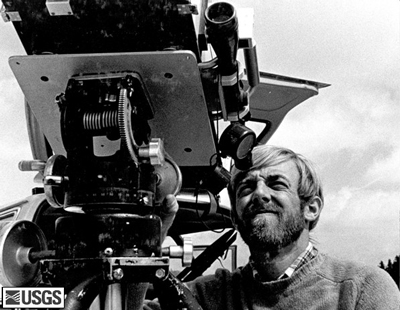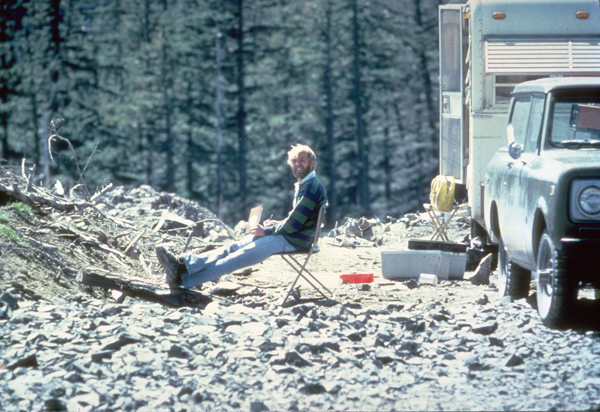Just over 39 years ago, Mount St. Helens in Washington erupted and claimed the lives of 57 people. One of those lost was Dr. David A. Johnston.
Johnston was the first volcanologist on the mountain’s flank when it stirred after more than 100 years of quiet. With a Ph.D. just 2 years old, Johnston was studying volcanic gas emissions with the U.S. Geological Survey to understand what part those emissions play before and during an eruption.
“He would call home and say, ‘I just can’t believe they’re paying me to do this!’”
“There are quotes from his parents, that he would call home and say, ‘I just can’t believe they’re paying me to do this!’” Melanie Holmes told Eos.
Holmes is the author of a new biography of Johnston titled A Hero on Mount St. Helens: The Life and Legacy of David A. Johnston. “His dream was absolutely to have a job with the U.S. Geological Survey, and there he was. He was doing what he loved.”
Johnston was at the Coldwater II observation post just outside the red zone when the volcano erupted on 18 May 1980. The night before, he had taken over the post from his field assistant, Harry Glicken. Glicken would continue studying active volcanoes until he lost his life 11 years later at Mount Unzen in Japan.
Johnston sent Glicken and two others away to safety that night, so it was Johnston who announced Mount St. Helens’s eruption to the world—“Vancouver! Vancouver! This is it!”—moments before his death.
“If I had to guess, I would say he enjoyed it so much because it was a puzzle,” Holmes said. “And who among us doesn’t love putting together the pieces of a puzzle that we’re just really fascinated with? For me it was the puzzle of a man and it was the puzzle of a mountain.”
Holmes spoke with Eos about the major influences in Johnston’s life and the mark he left on volcanology and the world. Our conversation has been edited for clarity, grammar, and length.
Eos: Looking back at the entirety of David Johnston’s life and the legacy he left behind, what do you feel are some of the most defining points in his life?

Holmes: I find it fascinating that he was among only two U.S. Geological Survey scientists who were looking into gas emissions as a way of determining what’s going on in a volcano and looking at precursory signals. It was him and Tom Casadevall, and they were both hired in 1978. Tom Casadevall was assigned to the Hawaiian Volcano Observatory to start a gas lab there. And David was working out of Menlo Park, Calif., but his area included the Cascades [and Mount St. Helens]. He was on his way to Alaska, and he would have expanded gas research there on Alaskan volcanoes. I find that fascinating, that he was one of only two volcanologists with the Survey who were looking into this. It feels very much like he was a pioneer.
David always referred to “a link in the chain. A link in the chain.”
And the Survey has said, since March of 1980 when Mount St. Helens became active again, that [evaluating] volcanic gas emissions has become an integral part of the Survey’s monitoring programs.
David always referred to “a link in the chain. A link in the chain.” He made that statement after he defended his dissertation on Augustine Volcano in Alaska. He felt like his work at Augustine was that link in the chain.
And in November of 1979, he did a geothermal study of the Azores, and he met with top officials there. Azorean officials ordered more studies based on what David suggested. He helped them map out their geothermal possibilities, places where they could create or expand. After he visited, Azoreans installed their first pilot plant, and their geothermal resources increased from there. And that’s very important. There is a statement in a letter of condolence that was sent to his parents by the Azorean regional director of energy [Deodato Sousa], who wrote to his parents and said, “David Johnston’s name will remain attached to the new era of energy in the Azores.”
Eos: Until I read the book, I didn’t fully realize how many programs and grants and fellowships and observatories and all sorts of things have been dedicated to Johnston and how many different aspects of this field he has inspired or shaped or touched.

Holmes: A seed for the book is the idea of a hero among heroes. So the title of the book [A Hero on Mount St. Helens], it definitely doesn’t have the word “the,” and it doesn’t even just say “hero.” It has to be “a hero” because there are so many heroes in his generation, in his immediate sphere, and all the places that the book touches upon.
We say that David touched the lives of so many people. It was the U.S. Geological Survey that enabled him to go to the Azores. It was whatever grad student stipend that allowed him to go to Augustine. There are all these intertwined heroic efforts that drove the science forward and that allowed someone like David to do what he was doing.
At Mount St. Helens, so many people felt like they should’ve known, right? Well, gas emissions were a part of that. [Experts] were expecting to see a higher level of gas emissions. So David insisted on getting to the volcano when he could. He went down into the summit crater—they called it the ephemeral ponds—to get an actual sample of that water. Twenty people could say that was reckless, but that was his way of saying, “Look, gas emission is an important part of the puzzle.” He landed at the summit crater rim on May 17, the day before he died. And I think he was frustrated that he wasn’t seeing the levels that they were expecting to see. Of course, we know now that the mountain was waterlogged, and that’s why. To respect those who went through so much and lost so much, we [must] always respect how young the science was at that time.
If we in Chicago or Cleveland or Detroit don’t understand why volcanoes research is important, then there’s always that possibility that down the road we’ll want those budgets slashed. That cannot happen.
Mount St. Helens is the most studied volcano in history.…There’s no getting around how much the eruption of Mount St. Helens contributed to science and therefore to the potential for safety for people of future generations—the people with volcanoes in their backyards.
As Midwesterners, we do not talk about volcanoes over dinner. Yet it is an important science that everyone in the United States must acknowledge is important and support its practitioners and make sure that budgets are there so that they can do their work. If we in Chicago or Cleveland or Detroit don’t understand why volcanoes research is important, then there’s always that possibility that down the road we’ll want those budgets slashed. That cannot happen.
Eos: Having grown up in the Chicago suburbs myself, I was raised with stories of the Oak Lawn tornado that struck Johnston’s hometown while he was in high school. How did living through that natural disaster and narrowly escaping the eruption of Augustine Volcano affect Johnston’s life and shape the direction of his career?
Holmes: David was only 17…when he went out into the streets of Oak Lawn with his dad taking pictures of the devastation. There was a girl from his high school that was killed.…So it all hit very close to home. His seeing the lack of being able to protect the innocent must’ve felt really personal for him.
He was empowered, I think, because he knew he could protect someone.
The people who’ve gone on after Mount St. Helens have all taken [a sense of responsibility] with them. And I cite some of those examples in the book, such as Carolyn Driedger and Mindy Brugman, who were on the ridge talking with David the night before and he sent them away. [Driedger] went on to work at the David A. Johnston Cascades Volcano Observatory, and she’s still there. It’s really important to someone who goes through something like that, where it just feels so personal and they think, they feel that they can do something to protect the innocent.
I think the Oak Lawn tornado was a very big part of it [for Johnston]. You could see how it fueled David. Here’s this person who’s been fainting from public speaking since eighth grade, and now he’s surrounded by reporters. There are microphones and cameras poised in front of his face, and it must’ve been really daunting for him. But he was empowered, I think, because he knew he could protect someone.
Eos: You acknowledge some of the personal struggles that Johnston faced in his younger years and during the start of his professional career: low self-esteem, bullying, anxiety, fainting. Why did you feel that those parts of his life and his experience, and his growth from them, were so important to go into?

Holmes: We look at him as a hero, but he was also human.…It goes back to the idea of can we see ourselves as a hero? The quote from Brad Meltzer in the epigraph of the introduction captures it: “We are all ordinary. We are all spectacular. We are all shy. We are all bold. We’re all heroes. We are all helpless. It just depends on the day.” Can we see ourselves in the story of someone that we revere so much?
Eos: What do you feel this holistic view of Johnston’s life teaches us about the scientific endeavor as a human experience?
Holmes: To my knowledge, this is the first biography of a volcanologist. It is a career path that is not well understood. One of the people who reviewed the book said, “It would’ve been really easy to lionize David’s life.” When we think about Einstein or Stephen Hawking, do we think about how they got to the point where they’ve made great discoveries? What came before that? Did they get all straight A’s?…Telling the story of David in boyhood and teen years, looking at how someone gets to the point where people look at them as, quote unquote, a hero—it seems important to look at the building of the man, if you will. And he got D’s in high school in math and algebra. So I’m looking at him as a human, and I think that makes him more approachable.
It also helps people to look and say to themselves, “I could do that.” And we need more people who say to themselves, “You know, I might’ve pulled D’s in algebra, but I can still do something really important with science. I can climb this mountain. I can conquer this challenge.”
—Kimberly M. S. Cartier (@AstroKimCartier), Staff Writer
Citation:
Cartier, K. M. S. (2019), Honoring volcanologist David Johnston as a hero and a human, Eos, 100, https://doi.org/10.1029/2019EO125589. Published on 27 June 2019.
Text © 2019. AGU. CC BY-NC-ND 3.0
Except where otherwise noted, images are subject to copyright. Any reuse without express permission from the copyright owner is prohibited.

